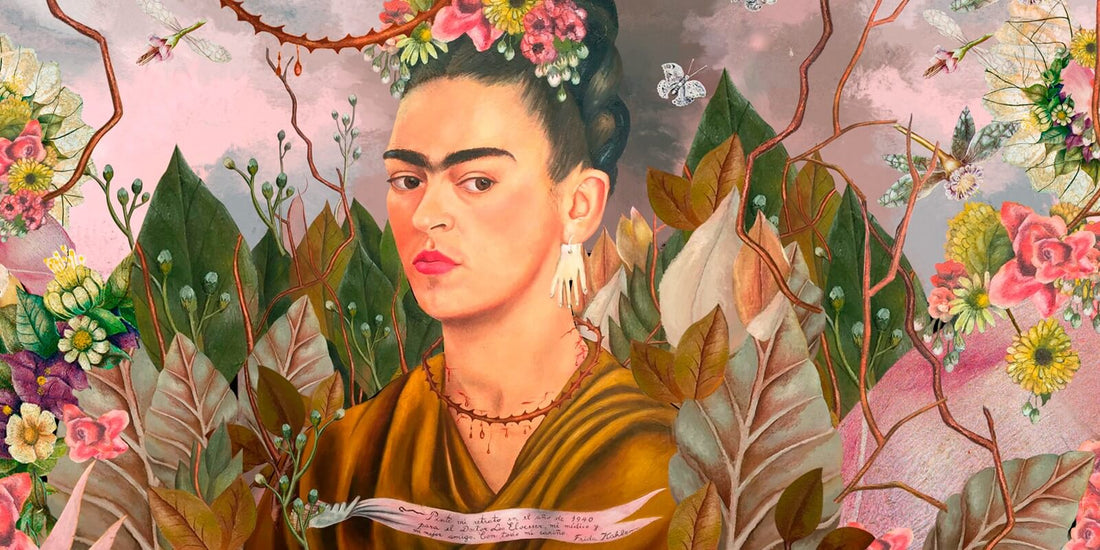
REMEMBERING FRIDA KAHLO
Today Selvedge celebrates the 115th anniversary of Frida Kahlo's birth.
The Mexican painter made herself the theme of her art. Her vibrant self-portraits intimately reflect her experiences, dreams, hopes and fears. Born in 1907, she suffered a serious accident at the age of eighteen. Although it left her crippled and unable to bear children, she was determined to live life to the full. In 1929 she married flamboyant artist Diego Rivera. Their tempestuous relationship was punctuated by divorce, remarriage, and numerous affairs.
Today Frida Kahlo and Diego Rivera have iconic status. Both, in their different ways, helped to shape the cultural identity of twentieth century Mexico. Many of Kahlo’s most powerfully autobiographical paintings show her surrounded by tropical fruit or flowers and dressed in regional clothing. Native clothing symbolised her political allegiance to the different cultures of Mexico, but it also shaped her own highly personal style. With her embroidered blouses, huaraches (sandals), fringed shawls and floor-length skirts, Frida caused a sensation wherever she went.

Image: Frida on a white bench. Image courtesy of Nickolas Murray
Frida mixed different costumes to make a carefully composed ensemble. There was, however, one combination that she favoured above all others: the costume of Zapotec women on the Isthmus of Oaxaca. Today, during festivals, the Tehuana women of Tehuantepec and Juchitán still wear a close-fitting top, termed a huipil, over a long gathered skirt with a flounce of starched lace at the hem. The velvet ground of gala garments is covered with large satin-stitched flowers. For added splendour, some women wear an elaborate headdress of starched lace. Tehuana women, widely regarded as sensuous and strong, play a dominant role in Isthmus life. Their poise and courage no doubt appealed to Frida.
At the end of her life, beset by pain and ill heath, Frida continued to dress as if each day was a fiesta. In life, as in art, she loved colour and alegría (gaiety). On her last birthday she wore a hand-woven tunic of white cotton, with a lavender tassel, from Yalalag in Oaxaca. Just days later she was dead. Chloë Sayer.
Frida was featured in various Selvedge issues, among them: issue 6 Blossom, issue 83 Cotton and 89 Latin. All of these issues are available in digital and print at www.selevdge.org.
The Mexican painter made herself the theme of her art. Her vibrant self-portraits intimately reflect her experiences, dreams, hopes and fears. Born in 1907, she suffered a serious accident at the age of eighteen. Although it left her crippled and unable to bear children, she was determined to live life to the full. In 1929 she married flamboyant artist Diego Rivera. Their tempestuous relationship was punctuated by divorce, remarriage, and numerous affairs.
Today Frida Kahlo and Diego Rivera have iconic status. Both, in their different ways, helped to shape the cultural identity of twentieth century Mexico. Many of Kahlo’s most powerfully autobiographical paintings show her surrounded by tropical fruit or flowers and dressed in regional clothing. Native clothing symbolised her political allegiance to the different cultures of Mexico, but it also shaped her own highly personal style. With her embroidered blouses, huaraches (sandals), fringed shawls and floor-length skirts, Frida caused a sensation wherever she went.

Image: Frida on a white bench. Image courtesy of Nickolas Murray
Frida mixed different costumes to make a carefully composed ensemble. There was, however, one combination that she favoured above all others: the costume of Zapotec women on the Isthmus of Oaxaca. Today, during festivals, the Tehuana women of Tehuantepec and Juchitán still wear a close-fitting top, termed a huipil, over a long gathered skirt with a flounce of starched lace at the hem. The velvet ground of gala garments is covered with large satin-stitched flowers. For added splendour, some women wear an elaborate headdress of starched lace. Tehuana women, widely regarded as sensuous and strong, play a dominant role in Isthmus life. Their poise and courage no doubt appealed to Frida.
At the end of her life, beset by pain and ill heath, Frida continued to dress as if each day was a fiesta. In life, as in art, she loved colour and alegría (gaiety). On her last birthday she wore a hand-woven tunic of white cotton, with a lavender tassel, from Yalalag in Oaxaca. Just days later she was dead. Chloë Sayer.
Frida was featured in various Selvedge issues, among them: issue 6 Blossom, issue 83 Cotton and 89 Latin. All of these issues are available in digital and print at www.selevdge.org.
